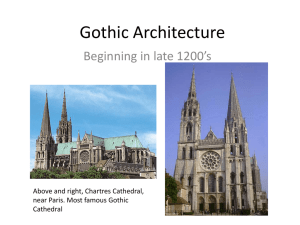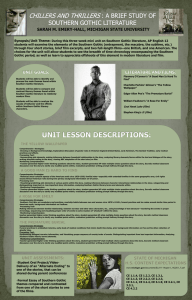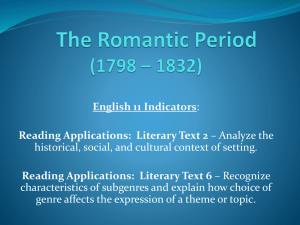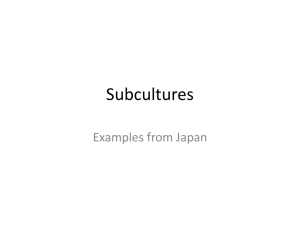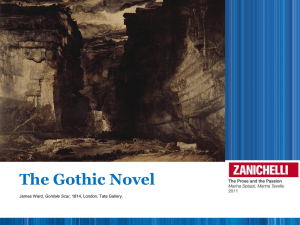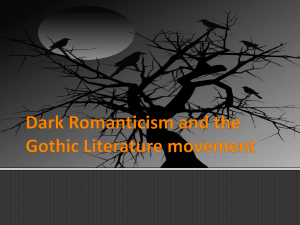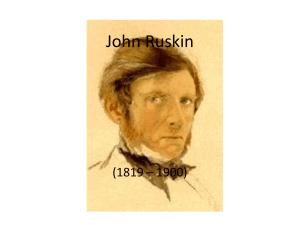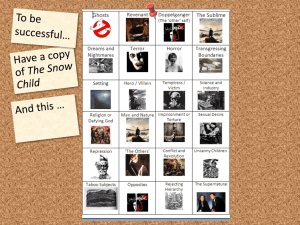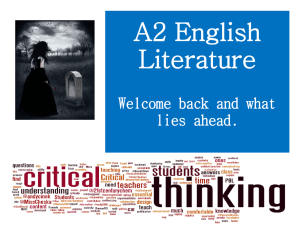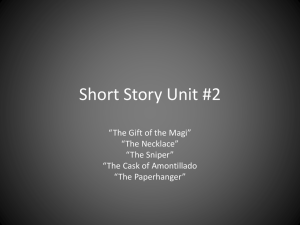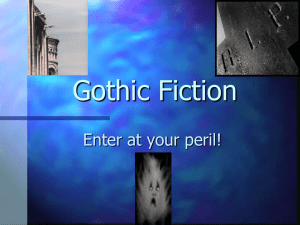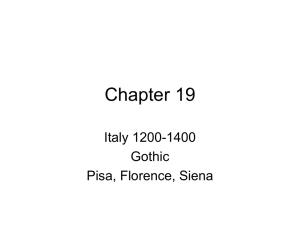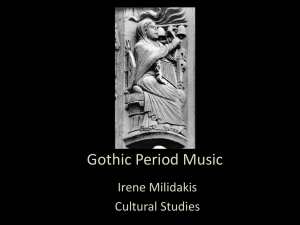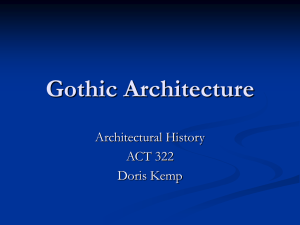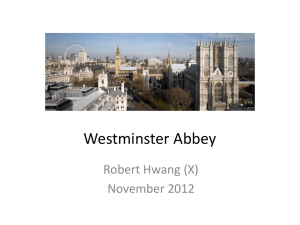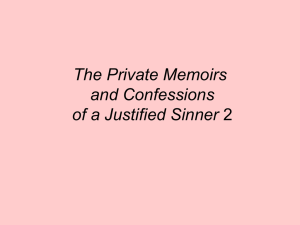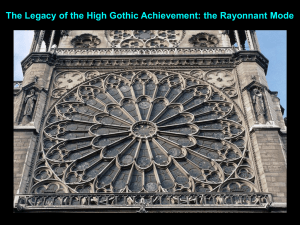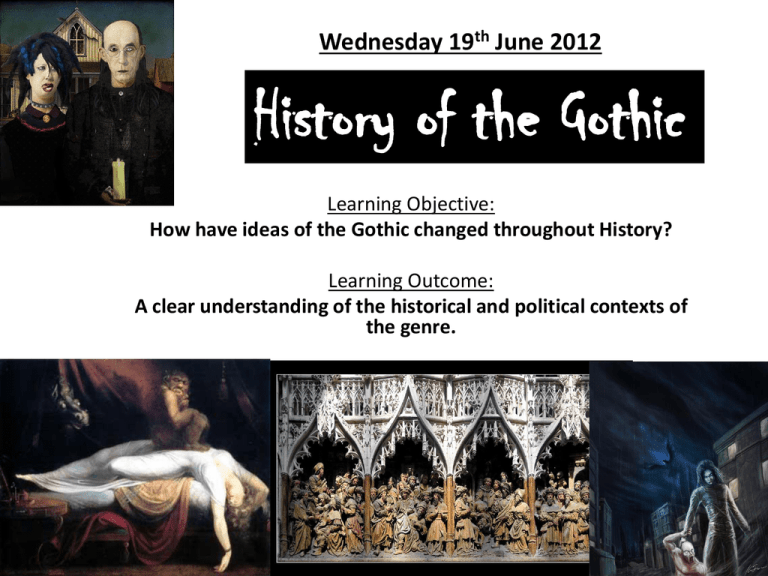
Wednesday 19th June 2012
History of the Gothic
Learning Objective:
How have ideas of the Gothic changed throughout History?
History of the Gothic
Learning Outcome:
A clear understanding of the historical and political contexts of
the genre.
Assessment Objectives
• AO4 Demonstrate understanding of the significance
and influence of the contexts in which literary texts
are written and received.
BAND 6: excellent understanding of a range of contextual factors
with specific, detailed links between context/texts/task.
BAND 3: some consideration of a range of contextual factors
shown by specific links between context/texts/tasks
What does this picture represent?
Annotate this picture with ideas, thoughts and feelings.
The Historical Context
The Visigoths were a Germanic tribe
instrumental in the disintegration of
the Roman Empire in the 5th century.
In the following centuries historians
came to regard ‘Goths’ generically as
all Germans – including of course the
Anglo-Saxons who settled in the British
Isles.
It could be argued that Gothic tradition
is ‘native’ to British culture.
Stick yer eyeliner,
I’m the ORIGINAL
Goth!
Artist impressions of the
Visigoths attacking Rome.
The Fall of Rome
Because of the cultural, political
and aesthetic association of Rome
with order, reason and
refinement, the Visigoth
destroyers of Rome came to be
understood as savage, brutal,
illiterate and irrational people.
The ‘Gothic’ was thus posited as
the antithesis not only of Rome,
but of a European Enlightenment
that regarded Rome as its model.
Summarise what you
have learnt in 50 words
or less!
18th century:
A period of MASSIVE political change
Horrible Histories
• Massive impact on the Western World
• International upheaval
The revolution was thought of as a traumatic
‘Gothic’ event – similar to the fall of Rome.
To Britain, in light of the French Revolution, the
‘Gothic’, Anglo Saxon ideal of constitution was
considered to be an antidote to dangerous
revolutionary aspirations.
Key Term: Constitution
Laws determining the principles of government.
England in the 18th century:
Political and social reform (change)
was gathering momentum.
Two main political parties:
Whigs – emerging middle class, growing in power:
did not believe in absolute monarchy (monarch
serving as sole source of power) but in
constitutional monarchy (monarch is head of
state but must act within the laws of their
parliament – like England today).
Tories – landed gentry: wanted a more powerful
monarchy as it protected their interests!
The Whigs believed that the original gothic love of
liberty could inform their argument for freedom
through political reform.
Illustration from a Whig
propaganda leaflet
The rise of the Gothic
in popular culture
ensued!
The Gothic took on mythical status, as the origin of
the country’s ancient constitution, allowing the
Whigs to distance from French Norman influence
(William the Conqueror – the first Norman King of
England, traditionally held up as the ‘beginning’ of
English politics).
In this context, Gothicism
was associated not with
barbarism, but with
freedom-loving people
who were the true
ancestors of the English.
I introduced laws that
gave the Crown and the
aristocracy more power
The rise of the Gothic in
popular culture ensued!
Summarise what you
have learnt in 50 words
or less!
Spiritual Context
Political and social uncertainties were rife during
this time of the gothic revival, and the period was
also characterised by immense spiritual
uncertainty.
In today’s more sceptical, less spiritual climate it is
difficult to appreciate the depths of passionate
feelings aroused by religious matters in the 18th
century.
The growth of rationalism had led to a devaluation
of religious experience – especially the mystical
dimension – to over simplifying a complex issue.
If nothing else, the Gothic put many of its
participants back in touch with the supernatural.
The Gothic deals with the undercurrents of religion:
the use of ‘magic’, contact with the dead, belief in
demons etc which, though unorthodox, are
inextricably linked to Christianity.
There are so many gothic associations that the whole
concept may seem at times indefinable and elusive.
Nevertheless, emerging is a sense of the gothic as
recovering and renewing a tradition which valued
feelings and sensibility, and which had been
usurped by the developing dominance of reason as
the key to all human problems.
Literary Link to The Enlightenment (17th & 18th Century)
Enlightenment – a reaction against blind faith and tradition
in favour of scientific, open enquiry. However, widespread
awareness was that over-reliance on reason could rob
human experience of its essential flavour.
Why was Gothic Fiction successful?
Middle class readers, safe in their enlightened, scientific,
explainable words, could feel secure enough to read stories
based on fears and fantasies. Enjoying the delicious thrill
while immune from any real danger.
1700
1764: Walpole’s The
Castle of Otranto was
published
1789 beginning of the French
Revolution, end of the
Enlightenment beginning of the
Romantic period
Summarise what you
have learnt in 50 words
or less!
Nineteenth Century ‘Victorian Gothic’
100 years after the French Revolution, the Gothic underwent a
variety of transformations. The stock conventions began to
change...
As a genre it began to take infiltrate other genres such as
detective fiction. It was even described at the time as
‘parasitical’.
The biggest change was that many writers began to set their
stories ‘closer to home’. In earlier Gothic texts the ‘terror’ took
place away from England, distancing the middle class reader
from it. Gothic villains and their victims were ‘othered’.
However, in the 19th century, industrialisation transformed
British society and created a deprived industrial working class
crammed into slums. These slums were frequently ‘gothicised’
by authors. This was called Victorian Domestic Realism and this
was a convention of the 19th century Gothic.
Another important convention was The Sensation Novel:
narrative focussed on the presence and ultimate revelation of a
secret to do with a crime within a family – bigamy, illegitimacy,
adultery or murder. Emphasis on scandal, secrecy and violence.
Dark impropriety in an otherwise respectable domestic setting.
OTHER
This is a
Gothic
Concept –
what does
it mean?
Summarise what you
have learnt in 50 words
or less!
CREATIVE TASK
Making use of today’s lesson and your ongoing research, write
an introductory leaflet entitled: The Student’s Guide to Gothic
Through the Ages (or a title of your choosing concerning the
same subject matter).
• The origins of the term ‘Gothic’ – in a historical sense
• The political, social and spiritual context of Gothic
literature
• A timeline of important events and periods of ‘The
Gothic’.
• How about 20th and 21st Century Gothic? Can you do
this yourself?

